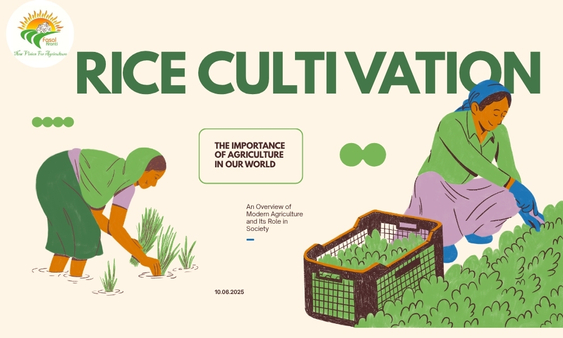
Rice is a staple food for more than 60% of India’s population, making it one of the most important crops in the country. India is the second-largest producer of rice globally, contributing around 20% of the world’s rice production. The diverse climatic conditions and soil types in India allow for various methods of rice cultivation.
In this article, we will explore the different types of rice cultivation practiced in India, their advantages, challenges, and regional preferences.
1. Traditional (Conventional) Rice Cultivation
Description:
Traditional rice cultivation is the oldest method, where farmers rely on natural rainfall and manual labor for planting, transplanting, and harvesting.
Process:
- Seed Selection: Farmers use locally adapted seeds.
- Nursery Preparation: Seeds are sown in a small nursery bed.
- Transplantation: Seedlings are manually transplanted into flooded fields.
- Water Management: Dependent on monsoon rains.
- Harvesting: Done manually using sickles.
Advantages:
- Low cost (minimal use of machinery).
- Suitable for small and marginal farmers.
Disadvantages:
- Labor-intensive.
- Low yield compared to modern methods.
Regions Practiced:
- West Bengal, Bihar, Odisha, and Assam.
2. System of Rice Intensification (SRI)
Description:
SRI is an innovative method that increases yield while reducing water and seed usage.
Process:
- Young Seedlings: 8-12 day-old seedlings are transplanted.
- Wider Spacing: Plants are spaced at 25×25 cm for better growth.
- Reduced Water: Fields are kept moist but not flooded.
- Organic Manure: Emphasis on compost and organic fertilizers.
Advantages:
- 30-50% higher yield.
- 40% less water requirement.
- Lower seed requirement (2 kg/acre vs. 20-30 kg in traditional).
Disadvantages:
- Requires skilled labor.
- Initial adaptation can be challenging.
Regions Practiced:
- Tamil Nadu, Andhra Pradesh, Karnataka.
3. Direct Seeding Rice (DSR)
Description:
DSR involves sowing seeds directly into the field instead of transplanting seedlings.
Process:
- Field Preparation: Laser leveling for uniform water distribution.
- Seed Sowing: Seeds are drilled into the soil using machines.
- Weed Management: Herbicides are often used to control weeds.
- Water Management: Intermittent irrigation instead of continuous flooding.
Advantages:
- Saves labor (no transplantation needed).
- 30% less water consumption.
- Faster crop establishment.
Disadvantages:
- Higher weed infestation risk.
- Requires precision farming techniques.
Regions Practiced:
- Punjab, Haryana, Western Uttar Pradesh.
4. Aerobic Rice Cultivation
Description:
Aerobic rice is grown in non-flooded, well-drained soils, similar to wheat cultivation.
Process:
- Soil Preparation: Well-leveled and aerated fields.
- Seed Sowing: Direct seeding with proper moisture.
- Irrigation: Light and frequent watering.
- Weed Control: Herbicides or manual weeding.
Advantages:
- Saves up to 50% water.
- Suitable for water-scarce regions.
Disadvantages:
- Lower yields compared to flooded rice.
- Requires high-quality seeds.
Regions Practiced:
- Maharashtra, Telangana, Karnataka.
5. Organic Rice Farming
Description:
Organic rice cultivation avoids synthetic fertilizers and pesticides, relying on natural inputs.
Process:
- Organic Manure: Use of compost, cow dung, and green manure.
- Natural Pest Control: Neem oil, biopesticides.
- Crop Rotation: Legumes and pulses are grown alternately.
Advantages:
- Environmentally sustainable.
- Higher market price for organic rice.
Disadvantages:
- Lower yield initially.
- Labor and cost-intensive certification process.
Regions Practiced:
- Kerala, Sikkim, Uttarakhand.
6. Hybrid Rice Cultivation
Description:
Hybrid rice is developed by cross-breeding two genetically different varieties for higher yield.
Process:
- High-Yield Seeds: Hybrid seeds are purchased.
- Intensive Care: Proper irrigation, fertilizers, and pest control.
- Mechanized Farming: Use of machinery for efficiency.
Advantages:
- 15-20% higher yield than traditional varieties.
- Better disease resistance.
Disadvantages:
- High seed cost.
- Requires more fertilizers and water.
Regions Practiced:
- Punjab, Haryana, Andhra Pradesh.
7. Flood-Prone Rice Cultivation
Description:
Special rice varieties are grown in flood-affected areas where water levels rise unpredictably.
Process:
- Deep-Water Varieties: Submergence-tolerant rice (e.g., Swarna-Sub1).
- Natural Adaptation: Plants grow taller to survive floods.
Advantages:
- Ensures crop survival in flood-prone zones.
Disadvantages:
- Lower yield potential.
Regions Practiced:
- Assam, Bihar, Eastern Uttar Pradesh.
Conclusion
India’s diverse agro-climatic conditions support multiple rice cultivation methods, each with unique benefits. While traditional methods remain prevalent, modern techniques like SRI, DSR, and hybrid rice are gaining popularity for their efficiency and sustainability.